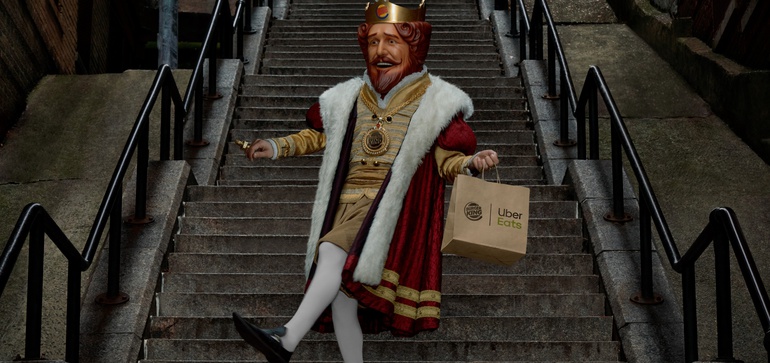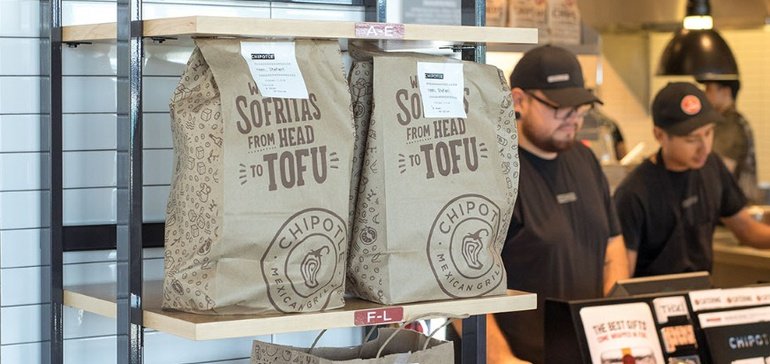Check out our latest post: The Threat of AI Disinformation to Your Brand

January has been a busy month for creative marketing ideas. The Consumer Electronics Show in Vegas gave brands the opportunity to show off their cutting-edge innovations, New Year’s resolutions and the Lunar New Year were launching points for some excellent opportunistic campaigns, and fast food trolling set its sights on a film with heavy Oscar buzz. Here’s a roundup of some of our favorite ideas from the first month of the roaring 2020s.
Consumer Electronics Show
The annual Consumer Electronics Show is an opportunity for large consumer brands to present new and upcoming innovations. As cutting-edge technologies such as hyper-personalization and artificial intelligence (AI) are being adopted more widely, consumer brands are leveraging them to improve the use of day-to-day products.
Delta
Delta CEO, Ed Bastian, was the first airline CEO to deliver a CES keynote, and his presentation focused on the future of air travel. There are a lot of big things in the works (hello, free Wi-Fi!), but the innovation with the most marketing implications is what Delta is calling “OOH Parallel Reality.”
Parallel Reality is the sci-fi marriage of hyper-personalized ad targeting and OOH (out-of-home) digital advertising. As travelers walk past digital screens in airports, Delta aims to show them personalized messaging in their language based on their individual itinerary, travel plans, and preferences. The potential for personalizing OOH advertising is huge for marketing — imagine if a billboard you were driving past or a digital screen in a mall retargeted you specifically with an ad for an outfit from your favorite brand that you recently viewed.
The real innovation here is the “multi-view pixels” that allow screens to show 100 different personalized messages on a single screen. As you can see in the video above, with multi-view pixels, three travelers can be standing directly next to each other looking at the same screen, and each person will see personalized information. Based on proprietary technology, Delta plans to beta test parallel reality screens in airports as soon as this summer.
Procter & Gamble
Procter & Gamble also made a splash at the Consumer Electronics Show, showcasing their brands Oral-B, Pampers, Charmin and Gillette. Oral B is leveraging artificial intelligence (AI) to deliver a personalized brushing experience, measuring brush pressure during use and turning that data into personalized coaching and motivation.

Pampers is taking baby monitoring to the next level with a baby care system utilizing AI, HD video monitoring and a connected app. The app compiles and aggregates baby’s sleep, feeding and diapering habits to give parents a holistic view of their baby’s patterns.
Procter & Gamble also had some fun with the spirit of innovation at CES with three conceptual bathroom prototypes in its Charmin showcase. “SmellSense” equips bathroom signage with real-time sensors alerting you whether or not a restroom is too smelly to enter.
Suddenly notice that you’re without toilet paper but it’s already too late? Not to worry, the “RollBot” delivers toilet paper rolls directly to the bathroom via smartphone command. No more desperately yelling across the house!
And the V.I.Pee is a fancy porta-potty for events outfitted with surround sound and a VR headset so you don’t have to miss a minute of the show (or focus on the fact that you’re in a porta-potty.)
CES gives consumer brands that aren’t traditionally associated with tech a chance to incorporate cutting-edge technology into everyday products, both playfully and in ways that could legitimately improve the day-to-day life of consumers.
Burger King

Popular fast-food restaurants are increasingly capitalizing on pop culture trends (while sticking it to their rivals at the same time). Burger King jumped on the bandwagon, and added an extra promotional layer to a recent campaign. Leveraging a hyper-targeted location and partnership with a delivery app, they playfully used a popular movie scene to lure local customers to order from their app (and reward them with free food).
Without even mentioning the highest-grossing R-rated movie of all time which inspired the promotion (“Joker”), the chain rewarded Bronx residents annoyed by the onslaught of tourists visiting the location of one of the iconic scenes. They offered free Whoppers when ordered from Uber Eats, and then took it a step further by taking a swipe at McDonald’s (and its clown mascot) with a video ad proclaiming, “We know clowns can be annoying.”
The recent release of the film’s DVD and ever-growing Oscar buzz makes the promotion even more relevant and exciting. Also, given the shift in consumer preferences, which now lean heavily towards online ordering, it’s a savvy and opportunistic way to connect with customers; 56% of people aged 21-38 have ordered delivery or takeout using a restaurant mobile app or website in the past year.
Nike
Chinese New Year began Saturday January 25, ushering in the Year of the Rat. Nike seized the opportunity with a lighthearted commercial spot playing on the holiday’s hongbao red envelopes that elders traditionally use to give children small gifts of money. Reminded by her mother to politely refuse the gift, a young girl straps on her Nikes to “outrun” her aunt’s generosity, as the two play a friendly game of tag over the years.
Nike takes a unique approach to an ancient holiday, basing the concept in tradition while using the plotline to playfully remind audiences to stay active during a festive time. This spot showcases their new line of Chinese New Year sneakers, inspired by the Year of the Rat.
Nike is known for its inclusive and cutting-edge ad campaigns. Their 2019 Dream Crazy ad, focusing on athletes of all stripes overcoming adversity and encouraging viewers to believe in their “craziest” dreams, won an Emmy for best commercial.
Nike also brought in $6.2 billion in revenue from Greater China last year, and China has been Nike’s fastest growing market for the last two years, so this playful Lunar New Year ad matches both the brand’s voice and overall business objectives.
Chipotle
We’re just about into the second month of 2020, and let’s face it: most people probably gave up on their New Year’s resolutions weeks ago. However, in an attempt to help those whose willpower could use some working on (as well as boost sales), Chipotle ran a promotion to help improve the eating habits of its customers.

Throughout the month of January, the burrito chain posted codes on Twitter that people could use to redeem free Lifestyle Bowls — a mix of salad greens and other healthy ingredients. On top of that, if you ordered a Lifestyle Bowl through Chipotle’s app, you would receive complimentary delivery.
The company’s leverage of social media is nothing new. In fact, its free food and delivery promotions last year helped them reach $1 billion in digital sales. In the past the chain has also used Twitter and Instagram promotionally in an attempt to capitalize on the ever-expanding amount of mobile users looking for restaurants to provide more convenience in the form of delivery. A smart move considering U.S. consumers using food delivery apps grew from 19% in 2018 to 25% in 2019.
Whether or not Chipotle chooses to reach mobile consumers using their own app, other food delivery apps like Uber Eats or Doordash, or by leveraging their social media platform with this kind of promotion, they’re cashing in on a trend in a very smart and relevant way.
